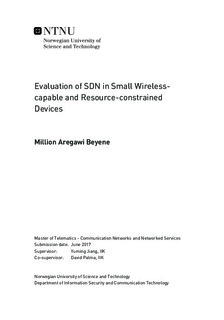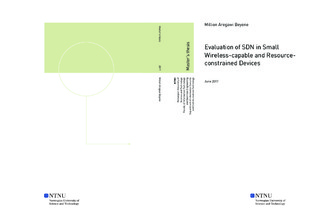| dc.description.abstract | Software Defined Networking (SDN) has recently emerged as the promising network architecture paradigm that is believed to revolutionize the networking world by making it more intelligent, flexible and programmable. SDN has mainly been researched for wired and data center networks. However, aligned with the evolution of Wireless Sensor Networks (WSN), Internet of Things (IoT) and similar technologies, we believe that the principles and potentials of SDN can be applied to a network of resource-constrained devices. The main objective of this thesis is to test if SDN can be deployed in a network of small wireless-capable and resource-constrained devices by setting up an experimental testbed, and then to evaluate its performance. The methodology used is real hardware-based experimentation and measurement instead of simulation. The rationale behind the choice is so as to undertake the evaluation in an environment that depicts reality and get reasonable results. A literature review of previous studies shows that most of the research works done are at an architectural or prototype level. However, the authors who suggested SDN for WIreless SEnsor Network (SDN-WISE) tried to implement their solution and made their source code publicly available. This thesis work uses SDN-WISE codebase as a starting point and further implementation of missing components and improvement of existing functionalities is carried out. A working hardware-based WSN testbed that uses SDN paradigm is implemented as one of the contributions of this thesis work. Software related contributions include implementation of a dynamic topology discovery, set of serial commands to program sensor nodes, a Python-based SDN controller, and a simple serial line based communication protocol between WSN and the SDN controller residing in a general purpose computer. The performance of the developed testbed is evaluated under different scenarios. The effects of topology, hop distance, and rate of packet arrival on the performance of the testbed have been analyzed. As the topology grows with more sensor nodes and becomes more complex, the performance declines. The same is true when the hop distance and rate of packet arrivals increase also. The ease of management, flexibility, and programmability provided by SDN, as witnessed in the experiments, convinced us to recommend and propose SDN as a viable solution for a network of small wireless-capable and resource-constrained devices. | |

